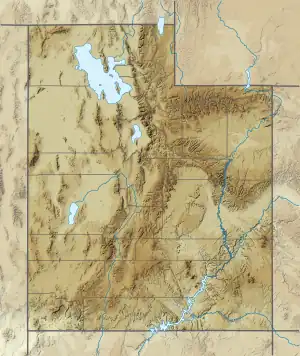Shunesburg Mountain
Shunesburg Mountain is a 5,960-foot (1,820 m) mountain in Zion National Park in Washington County, Utah, United States.[2]
| Shunesburg Mountain | |
|---|---|
 Shunesburg Mountain, west aspect | |
| Highest point | |
| Elevation | 5,960 ft (1,820 m)[1] |
| Prominence | 640 ft (200 m)[1] |
| Parent peak | Transview Mountain (6,321 ft)[1] |
| Isolation | 1.3 mi (2.1 km)[1] |
| Coordinates | 37°09′22″N 112°57′24″W[2] |
| Geography | |
 Shunesburg Mountain Location in Utah  Shunesburg Mountain Shunesburg Mountain (the United States) | |
| Location | Zion National Park Washington County, Utah United States |
| Parent range | Colorado Plateau |
| Topo map | USGS Springdale East |
| Geology | |
| Age of rock | Jurassic |
| Type of rock | Navajo sandstone |
Description
Shunesburg Mountain is situated 3.4 mi (5.5 km) southeast of Springdale, towering 2,000 feet (610 meters) above the floor of Parunuweap Canyon. It is wedged between Shunes Creek and the East Fork Virgin River which drain precipitation runoff from this mountain. This geographical feature is named for the ghost town of Shunesburg which was set between the west aspect of this mountain, and Johnson Mountain, 2 mi (3.2 km) to the northwest directly across the mouth of Parunuweap Canyon.[3][4] In turn, the town was named after Paiute Chief Shunes who sold the land in 1861 to the Mormon settlers who attempted to live there. Flooding from the Virgin River eventually forced the abandonment of the settlement, and drove the inhabitants to nearby Rockville.[5]
Climate
Spring and fall are the most favorable seasons to visit Shunesburg Mountain. According to the Köppen climate classification system, it is located in a Cold semi-arid climate zone, which is defined by the coldest month having an average mean temperature below 32 °F (0 °C), and at least 50% of the total annual precipitation being received during the spring and summer. This desert climate receives less than 10 inches (250 millimeters) of annual rainfall, and snowfall is generally light during the winter.[6]
References
- "Shunesburg Mountain - 5,960' UT". listsofjohn.com. Retrieved 2020-10-14.
- U.S. Geological Survey Geographic Names Information System: Shunesburg Mountain
- Ron Kay, Ron Kay's Guide to Zion National Park, Countryman Press, 2008, page 96.
- U.S. Geological Survey Geographic Names Information System: Shunesburg
- "Shunesburg UT" Washington County Historical Society (accessed 14 October 2020)
- "Zion National Park, Utah, USA - Monthly weather forecast and Climate data". Weather Atlas. Archived from the original on January 27, 2019. Retrieved 31 August 2020.
External links
- Zion National Park National Park Service
- Weather: Shunesburg Mountain